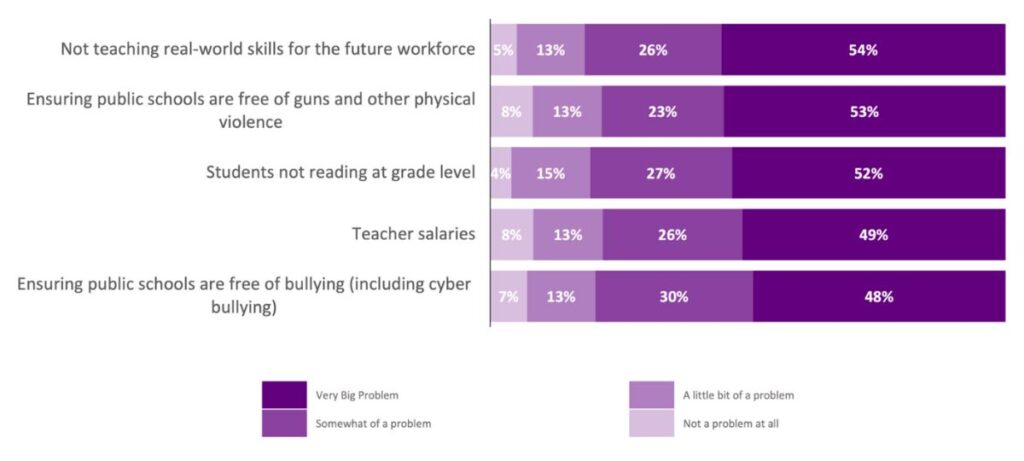What are those priorities? Though hot-button issues such as parental rights, book banning and school choice dominated education headlines during the pandemic, an online survey of 1,300 likely 2024 voters — including parents of school-age children — conducted by The Hunt Institute in summer 2023 found Americans now value very different things. In summarizing the survey’s findings, the institute issued a report titled 2023 Across the Aisle: Bridging the Education Divide to bring clarity about what voters agree are the top priorities related to public education. Among those that should guide district and school leaders’ decisions:
Safety
Nearly 80% of voters agree that ensuring schools are free from guns and other physical violence is a top priority. Little learning takes place when students and teachers feel unsafe. Not only did gun violence in schools double between 2020-21 and 2021-22, but bullying and unhealthy buildings also impact student safety. When young people feel unsafe, they are less likely to focus during class than their peers who feel safe — or may skip school altogether. Teachers and staff must be trained to identify warning signs of student disengagement and to employ intervention techniques. But with ESSER money no longer available, states and districts must find local sources of funds. For example, Colorado’s legislature expanded its Behavioral Health Care Professional Matching Grant Program to cover school behavioral health services and provide access to health care for school communities. Wisconsin doubled funding for school-based mental health programs in its 2019-21 state budget, aiding 120 public school districts with counseling and related services.
High-quality instruction
An overwhelming majority of voters prioritize ensuring that all students have access to well-trained and highly qualified educators and can read at grade level. Some 80% of survey respondents said hiring high-quality teachers is very important, while 66% stressed training and support for educators in the classroom. At a time when nearly 47% of schools had vacancies that went unfilled or were hard to fill in the 2020-21 school year, promising solutions — some started with ESSER funds — are underway. Thirty-one states and the District of Columbia are implementing or supporting teacher residencies with promising results. Similarly, Arizona and North Dakota governors issued executive orders creating task forces aimed at identifying promising practices, including data-informed retention programs.
Literacy
Achieving grade-level reading is essential for learning recovery. Though 75% of voters in the survey prioritized literacy, fourth-grade reading scores on the National Assessment of Educational Progress continue to decline. After third grade, students must transition from learning to read to reading to learn, which is crucial for academic success. Fourth-grade reading proficiency correlates to lifetime employment and earning potential — making literacy a priority not only for voters, but for the nation’s economic development.
Research indicates that adults with higher literacy skills are more likely to have better job opportunities and earn higher wages than their less literate peers.
States have aligned legislation with research-based literacy practices. In 2023, 17 states implemented policies focused on the science of reading, particularly in teacher training. Research-based literacy instruction benefits not only reading but also math, as the same areas of the brain are responsible for skills in both. For example, high-quality literacy instruction can help students understand mathematics because, as University of Buffalo researcher Christopher McNorgan found, the brain’s wiring for reading significantly impacts how it functions in relation to math.
Though federal ESSER funds must be allocated by September, the benefits and new practices that they paid for must continue. The U.S. Department of Education should consider compiling and sharing promising practices begun with ESSER investments, including teaching support, high-dosage tutoring, school safety, mental health and social services integrated with schools, so local policymakers can consider these examples and build on them.
Education leaders would benefit from using this opportunity to align long-term goals with voter values, ensuring students have access to quality teachers in a safe learning environment so they can gain the skills they will need long after graduation.



